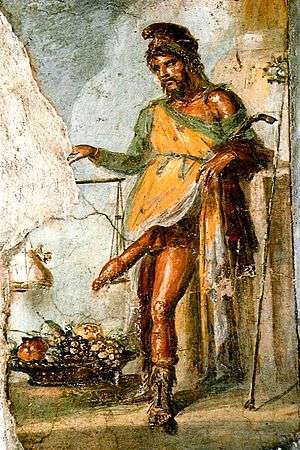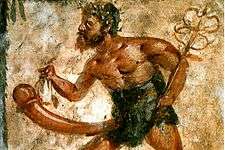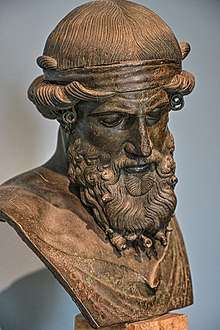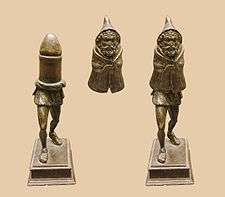Priapus
In Greek mythology, Priapus (/praɪˈeɪpəs/;[1] Ancient Greek: Πρῐ́ᾱπος, Príāpos) was a minor rustic fertility god, protector of livestock, fruit plants, gardens and male genitalia. Priapus is marked by his oversized, permanent erection, which gave rise to the medical term priapism. He became a popular figure in Roman erotic art and Latin literature, and is the subject of the often humorously obscene collection of verse called the Priapeia.
| Priapus | |
|---|---|
God of fertility, vegetables, nature, livestock, fruit, beekeeping, sex, genitals, masculinity, and gardens | |
 Fresco of Priapus, House of the Vettii, Pompeii | |
| Symbol | Donkey, flowers, fruit, vegetables, fish, bees |
| Personal information | |
| Parents | Aphrodite and Dionysus; Hermes and Aphrodite; Dionysus and Chione; Zeus and Aphrodite Pan |
| Siblings | Charites, Eros, Hermaphroditos, Hymenaios, Pan, satyrs |
| Roman equivalent | Mutunus Tutunus |
Relationship with other deities
Priapus was described in varying sources as the son of Aphrodite by Dionysus; as the son of Dionysus and Chione;[2] as perhaps the father or son of Hermes;[3] or as the son of Zeus or Pan.[4] According to legend, Hera cursed him with inconvenient impotence (he could not sustain an erection when the time came for sexual intercourse), ugliness and foul-mindedness while he was still in Aphrodite's womb, in revenge for the hero Paris having the temerity to judge Aphrodite more beautiful than Hera.[5] The other gods refused to allow him to live on Mount Olympus and threw him down to Earth, leaving him on a hillside. He was eventually found by shepherds and was brought up by them.
Priapus joined Pan and the satyrs as a spirit of fertility and growth, though he was perennially frustrated by his impotence. In a ribald anecdote told by Ovid,[6] he attempted to rape the goddess Hestia but was thwarted by an ass, whose braying caused him to lose his erection at the critical moment and woke Hestia. The episode gave him a lasting hatred of asses and a willingness to see them destroyed in his honour.[7] The emblem of his lustful nature was his permanent erection and his large penis. Another myth states that he pursued the nymph Lotis until the gods took pity on her and turned her into a lotus plant.[8]
Worship and attributes


The first extant mention of Priapus is in the eponymous comedy Priapus, written in the 4th century BC by Xenarchus. Originally worshipped by Greek colonists in Lampsacus in Asia Minor, the cult of Priapus spread to mainland Greece and eventually to Italy during the 3rd century BC.[9] Lucian (De saltatione) tells that in Bithynia Priapus was accounted as a warlike god, a rustic tutor to the infant Ares, "who taught him dancing first and war only afterwards," Karl Kerenyi observed.[10] Arnobius is aware of the importance accorded Priapus in this region near the Hellespont.[11] Also, Pausanias notes:
This god is worshipped where goats and sheep pasture or there are swarms of bees; but by the people of Lampsacus he is more revered than any other god, being called by them a son of Dionysus and Aphrodite.[12]
In later antiquity, his worship meant little more than a cult of sophisticated pornography.[13]
Outside his "home" region in Asia Minor, Priapus was regarded as something of a joke by urban dwellers. However, he played a more important role in the countryside, where he was seen as a guardian deity. He was regarded as the patron god of sailors and fishermen and others in need of good luck, and his presence was believed to avert the evil eye.[14]
Priapus does not appear to have had an organized cult and was mostly worshiped in gardens or homes, though there are attestations of temples dedicated to the god. His sacrificial animal was the ass, but agricultural offerings (such as fruit, flowers, vegetables and fish) were also very common.[9]
Long after the fall of Rome and the rise of Christianity, Priapus continued to be invoked as a symbol of health and fertility. The 13th century Lanercost Chronicle, a history of northern England and Scotland, records a "lay Cistercian brother" erecting a statue of Priapus (simulacrum Priapi statuere) in an attempt to end an outbreak of cattle disease.[15]
In the 1980s, D. F. Cassidy founded the St. Priapus Church as a modern church centred on worship of the phallus.[16][17]
Depictions

Priapus' iconic attribute was his priapism (permanently erect penis); he probably absorbed some pre-existing ithyphallic deities as his cult developed. He was represented in a variety of ways, most commonly as a misshapen gnome-like figure with an enormous erect phallus. Statues of Priapus were common in ancient Greece and Rome, standing in gardens. The Athenians often conflated Priapus with Hermes, the god of boundaries, and depicted a hybrid deity with a winged helmet, sandals, and huge erection.[8]
Another attribute of Priapus was the sickle which he often carries in his right hand. This too was used to threaten thieves, doubtless with castration:[18][19] Horace (Sat. 1.8.1–7) writes:[20]
- Olim truncus eram ficulnus, inutile lignum,
cum faber, incertus scamnum faceretne Priapum,
maluit esse deum. deus inde ego, furum aviumque
maxima formido; nam fures dextra coercet
obscenoque ruber porrectus ab inguine palus;
ast importunes volucres in vertice harundo
terret fixa vetatque novis considere in hortis. - "Once I was a trunk of fig, a useless piece of wood,
when a carpenter, unsure whether he should make a bench or a Priapus,
decided to make a god. So I am a god, of thieves and birds
a very great scarer; for my right hand curbs thieves,
as does the red pole which projects from my indecent groin;
but as for the importunate birds, the reed fixed on my head
terrifies them and forbids them to settle in the new gardens."
A number of epigrams, apparently written as if to adorn shrines of Priapus, were collected in the Priapeia. In these, Priapus frequently threatens sexual assault against potential thieves:[21]
- Percidere, puer, moneo; futuere, puella;
barbatum furem tertia poena manet. - "I warn you, boy, you will be screwed; girl, you will be laid with;
a third penalty awaits the bearded thief."
- Femina si furtum faciet mihi virve puerve,
haec cunnum, caput hic praebeat, ille nates. - "If a woman steals from me, or a man, or a boy,
let the first give me her cunt, the second his head, the third his buttocks."
- per medios ibit pueros mediasque puellas
mentula; barbatis non-nisi summa petet. - "My dick will go through the middle of boys and the middle of girls,
but with bearded men it will aim only for the top."
A number of Roman paintings of Priapus have survived. One of the most famous images of Priapus is that from the House of the Vettii in Pompeii. A fresco depicts the god weighing his phallus against a large bag of coins. In nearby Herculaneum, an excavated snack bar has a painting of Priapus behind the bar, apparently as a good-luck symbol for the customers.
In literature
As well as the collection known as the Priapeia mentioned above, Priapus was a frequent figure in Latin erotic or mythological verse.
In Ovid's Fasti,[22] the nymph Lotis fell into a drunken slumber at a feast, and Priapus seized this opportunity to advance upon her. With stealth he approached, and just before he could embrace her, Silenus's donkey alerted the party with "raucous braying". Lotis awoke and pushed Priapus away, but her only true escape was to be transformed into the lotus tree. To punish the donkey for spoiling his opportunity, Priapus bludgeoned it to death with his gargantuan phallus. In later versions of the story, Lotis is replaced with the virginal goddess Hestia. Ovid's anecdote served to explain why donkeys were sacrificed to Priapus in the city of Lampsacus on the Hellespont, where he was worshipped among the offspring of Hermes.[23]
Priapus is repeatedly mentioned in Petronius's Satyricon. William Arrowsmith, in the introduction and notes to his translation of the work, draws parallels between his hounding of the protagonist and that of Poseidon in Homer's Odyssey.
Priapus is mentioned in Geoffrey Chaucer's "The Merchant's Tale", part of The Canterbury Tales. During a description of a garden that the protagonist, Januarie, creates, Priapus is invoked in his form as God of gardens:
Ne Priapus ne myghte nat suffise,
Though he be God of gardyns, for to telle
The beautee of the gardyn and the welle,
That stood under a laurer alwey grene.[24]
(Priapus might not suffice,
Though he be god of gardens, to tell
Of the beauty of the garden and the well
That stood under the laurel, always green.)
Priapus serves to remind the reader, or listening audience, that Januarie's intentions are driven by lust and not love.
Priapus is mentioned in Pericles, Prince of Tyre, which was partially written by William Shakespeare. A brothel owner referred to as a 'Bawd' says that Pericles' daughter Marina is "able to freeze the god Priapus, and undo a whole generation."
Priapus is mentioned in William Carlos Williams's poem "Paterson". Priapus is also mentioned in John Steinbeck's East of Eden: "She conducted her house like a cathedral dedicated to a sad but erect Priapus."
Priapus is referred to in Henry Miller's 1939 novel Tropic of Capricorn, in a passage railing against society's refusal to talk about sex as an act of pleasure.
T.S. Eliot refers to Priapus in his poem "Mr. Appolinax" (published in Prufrock and Other Observations, 1920):
When Mr. Apollinax visited the United States
His laughter tinkled among the teacups.
I thought of Fragilion, that shy figure among the birch-trees,
And of Priapus in the shrubbery
Gaping at the lady in the swing.
Priapus is also mentioned in Vladimir Nabokov's Invitation to a Beheading: "Or when you, with eyes closed tight, devouring a spurting peach and then, having finished, but still swallowing, with your mouth still full, you cannibal, your glazed eyes wandered, your fingers were spread, your inflamed lips were all glossy, your chin trembled, all covered with drops of the cloudy juice, which trickled down onto your bared bosom, while the Priapus who had nourished you suddenly, with a convulsive oath, turned his back to me, who had entered the room at the wrong moment."
Priap[us] is mentioned as well in Nabokov's Lolita: "She was the loveliest nymphet green-red-blue Priap himself could think up".
Patron of merchant sailing
Priapus' role as a patron god for merchant sailors in ancient Greece and Rome is that of a protector and navigational aide. Recent shipwreck evidence contains apotropaic items carried onboard by mariners in the forms of a terracotta phallus, wooden Priapus figure, and bronze sheath from a military ram. Coinciding with the use of wooden Priapic markers erected in areas of dangerous passage or particular landing areas for sailors, the function of Priapus is much more extensive than previously thought.[25]
Although Priapus is commonly associated with the failed attempts of rape against the nymphs Lotis and Vesta in Ovid's comedy Fasti[26] and the rather flippant treatment of the deity in urban settings, Priapus' protection traits can be traced back to the importance placed on the phallus in ancient times (particularly his association with fertility and garden protection).[25] In Greece, the phallus was thought of to have a mind of its own, animal-like, separate from the mind and control of the man.[27] The phallus is also associated with "possession and territorial demarcation" in many cultures, attributing to Priapus' other role as a navigational deity.[25]
Modern derivations
Medical terminology
The medical condition priapism derives its name from Priapus, alluding to the god's permanently engorged penis.
Natural history
- The group of worm-like marine burrowing animals known as the Priapulidea, literally "penis worms", also derives its name from Priapus.
- Mutinus caninus, a woodland fungus, draws its first name from Priapus's Roman name, due to its phallic shape.
In popular culture
- It has been suggested by some scholars that the modern popular garden gnome is a descendant of Priapus.[28]
- In Sherrilyn Kenyon's Fantasy Lover, Priapus is Julian's half-brother, who cursed him to live in the book and only come out to be someone's lover from full moon to full moon.
- Doujinshi artist Mentaiko wrote a bara doujinshi manga inspired by the Priapus mythos in 2011. The manga is currently ongoing.[29]
- Nicolas Presl interprets the myth in his wordless graphic novel "Priape" (Genève, Atrabile, 2006)
- 2014 Indie Game A Date in the Park uses Priapus as a clue for the main character to find his love interest.
See also
- Priapeia
- Latin obscenity
- Sexuality in ancient Rome
- Karabiga, Turkey, formerly known as Priapus
- Richard Payne Knight
References
Notes
- "Priapus". Collins Dictionary. n.d. Retrieved 24 September 2014.
- Scholia on Theocritus, 1. 21
- Kerenyi, Gods of the Greeks, 1951, p. 175, noting G. Kaibel, Epigrammata graeca ex lapidibus collecta, 817, where the other god's name, both father and son of Hermes, is obscured; Hyginus (Fabulae 160) makes Hermes the father of Pan.
- "Priapus". The Oxford Companion to World Mythology. David Leeming. Oxford University Press, 2004.
- An elaboration on a scholium on Apollonius of Rhodes' Argonautica i. Kereny remarks of the jealousy of Hera in this case, "a cheap theme, and certainly not an ancient one" (Kerenyi 1951, p.176).
- Ovid, Fasti, vi.319ff
- "Priapus." Who's Who in Classical Mythology, Routledge. 2002.
- "Priapus." Bloomsbury Dictionary of Myth. 1996.
- Robert Christopher Towneley Parker. "Priapus". The Oxford Classical Dictionary. Ed. Simon Hornblower and Anthony Spawforth. Oxford University Press 2003.
- Kerenyi, Gods of the Greeks, 1951, p. 154, also pp. 175–77. .
- In ridiculing the literal aspects of pagan gods given human form, he mentions "the Hellespontian Priapus bearing about among the goddesses, virgin and matron, those parts ever prepared for encounter." (Arnobius, Seven Books against the Heathen III.10 (on-line text).
- Pausanias, Description of Greece 9.31.2.
- Mark P.O. Morford, Robert J. Lenardon, Michael Sham. (2011, 9th ed.). "Classical Mythology" (New York, NY.: Oxford University Press) ISBN 978-0-19-539770-3
- "Priapus." Encyclopædia Britannica. 2007
- Yves Bonnefoy, Roman and European Mythologies, pp. 139–142. University of Chicago Press, 1992. ISBN 0-226-06455-7
- J. Gordon Melton (1996, 5th ed.). Encyclopedia of American Religions (Detroit, Mich.: Gale) ISBN 0-8103-7714-4 p. 952.
- Andy Nyberg, "St. Priapus Church: The Organized Religion", The Advocate, Sep. 1983, pp. 35–37.
- deMause, Lloyd (ed.) (1976), The History of Childhood, p. 46.
- For the sickle used for the castration of sacrificial animals, see Burkert, Walter (1983) Homo Necans: The Anthropology of Ancient Greek Ritual and Myth, translated by Peter Bing, p. 68, quoting Martial 3.24.
- Moul, V. A. (2016). "The Source for Priapus in Cowley’s Ode “To The Royal Society” (1667)", p. 3.
- Craig A. Williams, Roman Homosexuality: Ideologies of Masculinity in Classical Antiquity, p. 21. Oxford University Press US, 1999. ISBN 0-19-512505-3
- Fasti, 6.319ff.
- Hyginus, Fabulae, 160.
- G. Chaucer, The Merchant's Prologue and Tale, (Cambridge University Press, Cambridge, 2006), p63
- Neilson III, Harry R. 2002. "A terracotta phallus from Pisa Ship E: more evidence for the Priapus deity as protector of Greek and Roman navigators." The International Journal of Nautical Archaeology 31.2: 248–253.
- Fantham, Elaine. 1983. "Sexual Comedy in Ovid's Fasti: Sources and Motivation." Harvard Studies in Classical Philology 87: 185.
- Csapo, Eric. 1997. "Riding the Phallus for Dionysus: Iconology, Ritual, and Gender-Role De/Construction." Phoenix 51.3/4: 260.
- Peter D. Arnott, An Introduction to the Roman World. London: MacMillan, 1970; Judith Harris, Pompeii Awakened: A Story of Rediscovery. I.B.Tauris, 2007, p. 117. ISBN 1-84511-241-5. Hugh Lloyd-Jones, Greek in a Cold Climate. Rowman & Littlefield, 1991, p. 64. ISBN 0-389-20967-8.
- http://www.mangago.me/read-manga/priapus/
Bibliography
- Brown, Emerson, Jr. "Hortus Inconclusus: The Significance of Priapus and Pyramus and Thisbe in the Merchant's Tale". Chaucer Review 4.1 (1970): 31–40.
- “Priapus and the Parlement of Foulys”. Studies in Philology 72 (1975): 258–74.
- Coronato, Rocco. “The Emergence of Priapism in the Two Gentlemen of Verona”. In Proteus: The Language of Metamorphosis, ed. Carla Dente, George Ferzoco, Miriam Gill and Marina Spunta. Aldershot: Ashgate, 2005, chapter 8, 93–101.
- Delord, Frédéric. "Priapus". 2009. In A Dictionary of Shakespeare's Classical Mythology (2009–), ed. Yves Peyré.
- "'O, the difference of man and man!' (IV.ii.26): Références et différences génitales dans King Lear" in Autour de King Lear, ed. A. Lafont and M.-C. Munoz, with F. Delord. Montpellier: IRCL, February 2009.
- Érubescences et turgescences dans l’imaginaire shakespearien et la culture de la Renaissance, thèse dactylographiée (Ph.D). Montpellier : Université Montpellier III – Paul Valéry, 2008.
- Franz, David O. "Leud Priapians and Renaissance Pornography". SEL: Studies in English Literature 1500–1900 12, n°1 (winter 1972): 157–72.
- Morel, Philippe. "Priape à la Renaissance: Les guirlandes de Giovanni da Udine à la Farnésine". Revue de l’Art 69 (1985): 13–28.
- Peyré, Yves. "Priape dénaturé: Remarques sur les Apotheseos…Deorum Libri Tres de Georges Pictor et leur adaptation anglaise par Stephen Batman". Influences latines en Europe (Cahiers de l’Europe Classique et Néo-Latine). Toulouse: Travaux de l’Université de Toulouse – Le Mirail, A.23 (1983): 61–87.
External links
| Wikimedia Commons has media related to Priapus. |
![]()
- Chisholm, Hugh, ed. (1911). . Encyclopædia Britannica (11th ed.). Cambridge University Press.
- Britannica Online Encyclopedia
- Dictionary of Greek and Roman Biography and Mythology
- Priapos: Greek & Mysian God of Gardens and Fertility – Theoi Project
